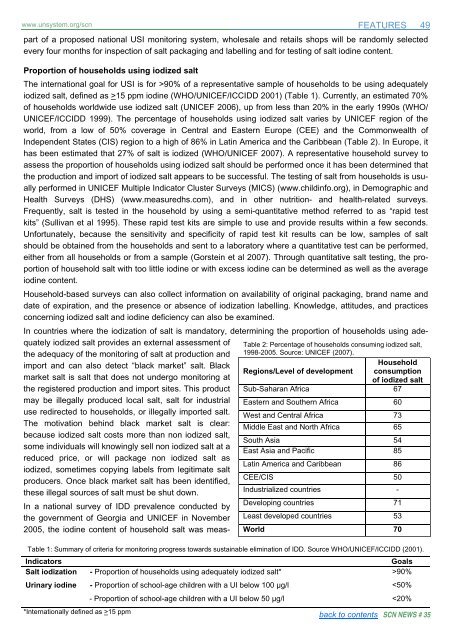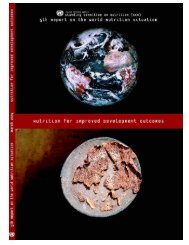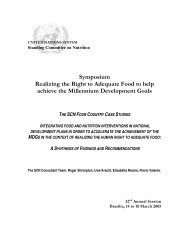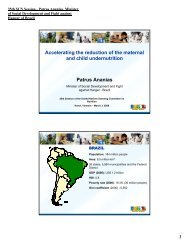Universal Salt Iodization (USI) - FTP Directory Listing
Universal Salt Iodization (USI) - FTP Directory Listing
Universal Salt Iodization (USI) - FTP Directory Listing
- No tags were found...
You also want an ePaper? Increase the reach of your titles
YUMPU automatically turns print PDFs into web optimized ePapers that Google loves.
www.unsystem.org/scn FEATURES 49part of a proposed national <strong>USI</strong> monitoring system, wholesale and retails shops will be randomly selectedevery four months for inspection of salt packaging and labelling and for testing of salt iodine content.Proportion of households using iodized saltThe international goal for <strong>USI</strong> is for >90% of a representative sample of households to be using adequatelyiodized salt, defined as >15 ppm iodine (WHO/UNICEF/ICCIDD 2001) (Table 1). Currently, an estimated 70%of households worldwide use iodized salt (UNICEF 2006), up from less than 20% in the early 1990s (WHO/UNICEF/ICCIDD 1999). The percentage of households using iodized salt varies by UNICEF region of theworld, from a low of 50% coverage in Central and Eastern Europe (CEE) and the Commonwealth ofIndependent States (CIS) region to a high of 86% in Latin America and the Caribbean (Table 2). In Europe, ithas been estimated that 27% of salt is iodized (WHO/UNICEF 2007). A representative household survey toassess the proportion of households using iodized salt should be performed once it has been determined thatthe production and import of iodized salt appears to be successful. The testing of salt from households is usuallyperformed in UNICEF Multiple Indicator Cluster Surveys (MICS) (www.childinfo.org), in Demographic andHealth Surveys (DHS) (www.measuredhs.com), and in other nutrition- and health-related surveys.Frequently, salt is tested in the household by using a semi-quantitative method referred to as “rapid testkits” (Sullivan et al 1995). These rapid test kits are simple to use and provide results within a few seconds.Unfortunately, because the sensitivity and specificity of rapid test kit results can be low, samples of saltshould be obtained from the households and sent to a laboratory where a quantitative test can be performed,either from all households or from a sample (Gorstein et al 2007). Through quantitative salt testing, the proportionof household salt with too little iodine or with excess iodine can be determined as well as the averageiodine content.Household-based surveys can also collect information on availability of original packaging, brand name anddate of expiration, and the presence or absence of iodization labelling. Knowledge, attitudes, and practicesconcerning iodized salt and iodine deficiency can also be examined.In countries where the iodization of salt is mandatory, determining the proportion of households using adequatelyiodized salt provides an external assessment of Table 2: Percentage of households consuming iodized salt,the adequacy of the monitoring of salt at production and 1998-2005. Source: UNICEF (2007).import and can also detect “black market” salt. BlackHouseholdRegions/Level of development consumptionmarket salt is salt that does not undergo monitoring atof iodized saltthe registered production and import sites. This product Sub-Saharan Africa 67may be illegally produced local salt, salt for industrial Eastern and Southern Africa 60use redirected to households, or illegally imported salt. West and Central Africa 73The motivation behind black market salt is clear:Middle East and North Africa 65because iodized salt costs more than non iodized salt,South Asia 54some individuals will knowingly sell non iodized salt at aEast Asia and Pacific 85reduced price, or will package non iodized salt asLatin America and Caribbean 86iodized, sometimes copying labels from legitimate saltCEE/CIS 50producers. Once black market salt has been identified,these illegal sources of salt must be shut down.Industrialized countries -Developing countries 71In a national survey of IDD prevalence conducted bythe government of Georgia and UNICEF in November Least developed countries 532005, the iodine content of household salt was meas- World 70Table 1: Summary of criteria for monitoring progress towards sustainable elimination of IDD. Source WHO/UNICEF/ICCIDD (2001).IndicatorsGoals<strong>Salt</strong> iodization - Proportion of households using adequately iodized salt* >90%Urinary iodine - Proportion of school-age children with a UI below 100 μg/l 15 ppm- Proportion of school-age children with a UI below 50 μg/l







